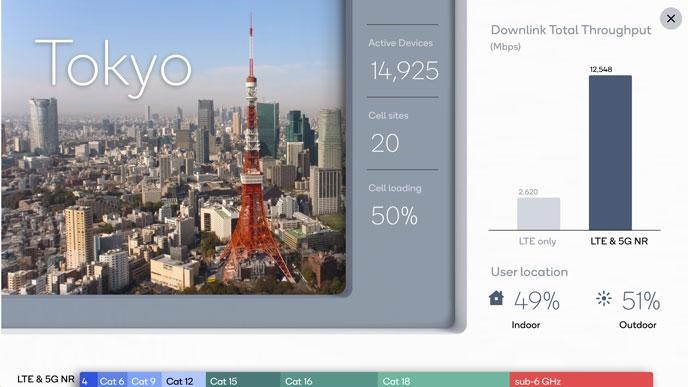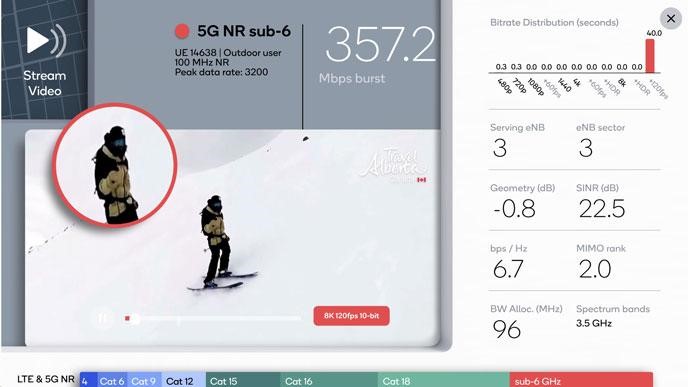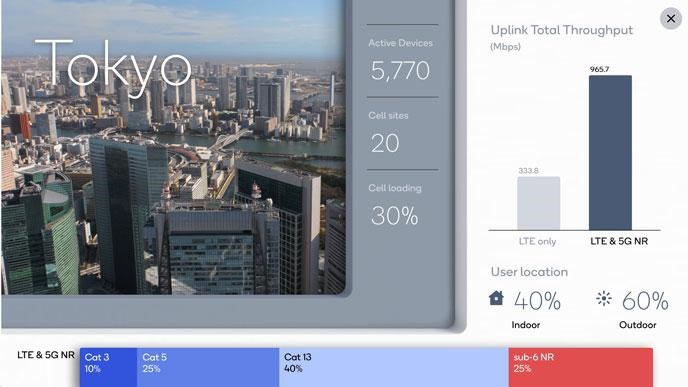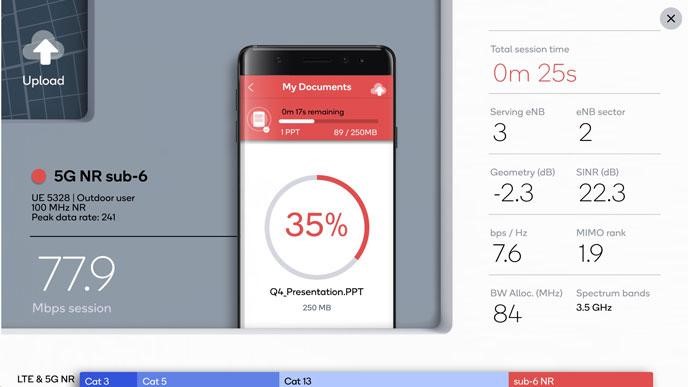User experience in 5G NR networks expected in real conditions

This year, 3GPP members have adopted the 5G NR specifications for network offline deployment (SA). These specifications should provide support for new features — from network segmentation (network slicing) to greater granularity of quality of service (QoS) levels. In order to predict the real performance of devices with support for 5G and Gigabit LTE, working in a network with an autonomous implementation of the architecture (SA), large-scale modeling was carried out using data from operators around the world. We offer to get acquainted with the results in more detail.
Download speed tests on 5G NR networks up to 6 GHz in Tokyo
The 5G NR SA macro network segment model in Tokyo included 20 new 5G NR base stations located on the same sites as the existing LTE cells. The 5G NR network model in Tokyo operated in the 100 MHz band at 3.5 GHz, and the Gigabit LTE TDD core network in three LTE spectrum bands (3 × 20 MHz) (in Figure 1). The distribution between base stations and devices was modeled on the basis of high-resolution 3D maps of Tokyo, taking into account possible losses during signal propagation, shading, diffraction, losses during passage through buildings, interference, etc.
In addition, the simulation included the use of various radio technologies, including Massive MIMO for 5G NR with 256 antenna elements and 4x4 MIMO for LTE TDD networks.
')
The simulation used several types of traffic that mimic the use of devices in real conditions, namely browsing, file downloads and streaming video playback. In addition, the simulation was carried out for different mixtures (mix) of end devices with different RF capabilities (smartphones of different LTE categories).

Figure 1: 5G NR network capacity simulation results in Tokyo for a range of up to 6 GHz in offline mode (SA)
More than 12,000 active user devices of various types were randomly distributed across the network, with approximately 50% of them being inside (indoor) and 50% outside (outdoor). The tests demonstrated an increase in network bandwidth for downlink data by about 5 times when switching from an LTE TDD network with a mixture of LTE devices from various categories to a 5G NR network using multi-mode devices supporting 5G NR and Gigabit LTE. Another significant advantage was that the median indices of spectral efficiency increased by 3 times.
The simulation also gave an idea of the real user experience of interacting with new networks. Key indicators obtained at various network loadings were used for its evaluation. Measurements were carried out while browsing (uneven traffic, browsing the Internet and social networks), downloading high-resolution movies (3 GB in size) from cloud storage, as well as streaming 360-degree video (resolution 8K, 120 frames per second, adaptive bitrate).
An example of the operation of the 5G NR device in the Tokyo network is shown in Figure 2. The maximum download speed reached 357 Mbit / s, which made it possible to transfer and play lossless video in 8K resolution at 120 fps (the bitrate distribution graph is in the right part of the figure). Also shown in Figure 2 are the main indicators obtained during the simulation, including data transfer rate, signal quality, spectral efficiency, MIMO rank, and spectrum frequencies.

Figure 2: Key indicators for streaming video using 5G NR networks in the range up to 6 GHz in offline mode (SA)
The simulation also made it possible to compare how devices in the network transmit data in terms of different signal quality - in 10th (weak signal / work “on the edge of the cell”), 50th (average signal quality) and 90th percentiles (ideal conditions) .
Brief results are as follows (see Figure 3):
- More than threefold increase in download speeds during web surfing: 102 Mbps for the median category of 4G LTE users versus 333 Mbps in 5G NR networks;
- an approximately threefold decrease in response time was observed: the median delay in loading decreased from 48 to 14 ms;
- about a fourfold increase in the speed of downloading files in conditions of a weak signal is visible: 131 Mbps from 90% of users on the 5G network versus 32 Mbps from users on the LTE network;
- For users, in the 10th percentile, the quality of streaming video increased from 480p at 30 fps from 8-bit color rendering (LTE) to 8K at 120 fps from 10-bit color and above (5G).

Figure 3: User experience on LTE Cat 9 and 5G NR devices in comparison
The results indicate not only the increase in the speed of data transmission in 5G networks, but also the stable quality of communication even when working on the edge of the cell, which allows us to think about completely new scenarios for the use of such networks.
The simulation also allowed for a general comparison of various categories of devices in specific conditions. In Figure 4, in particular, you can see that:
- recorded a significant increase in performance when using 5G NR networks, for example, a speed increase to a gigabit level, reduced latency, stable communication quality and increased network capacity;
- Gigabit LTE networks are important for providing fast and stable communications for users who leave 5G NR coverage.

Figure 4: Key indicators for modeling in Tokyo with irregular traffic - data taking into account the results obtained from the devices of the 90th percentile
Uplink Modeling (uplink) on 5G NR networks up to 6 GHz in Tokyo
Achievable data rates using 5G networks are often the subject of active discussion. And almost always we are talking about the speed in the descending channel from the network and what new opportunities this can give, but very little is said about the speed in the uplink channel (uplink). But the last parameter is no less important, because application developers need to understand what speed in the uplink should be expected from the networks of the new generation before they start developing or updating their products.
That is why we were the first in the industry to add the ability to announce detailed modeling of data upload speeds as part of our platform for testing the capabilities of 5G NR networks and user experience of interacting with them. This platform is designed so that it provides quantitative data on the expected real-world network performance in data upload and user experience when working with multi-mode 5G NR and Gigabit LTE TDD devices operating in 4G / 5G NR autonomous architecture networks.
As can be seen in Figure 5, the tests showed an almost threefold increase in the speed of data unloading during the transition using a mixture of various devices from LTE networks to 5G NR networks.

Figure 5: Simulated 5G NR autonomous architecture capabilities in the range below 6 GHz for the uplink data channel
Figure 6 shows an example of a 5G NR device that implements a traffic model that corresponds to loading into the cloud the PowerPoint file. The maximum upload speed in this usage scenario reached 78 Mbps and it took less than 30 seconds to transfer the file. The figure also shows key indicators, including signal quality, spectral efficiency, MIMO rank, and spectrum frequencies.

Figure 6: File upload speed and key indicators when using 5G NR SA networks in the range below 6 GHz
Broadcasting live video content is another important example of the use of modern devices. The quality of the broadcast here is directly dependent on the speed of uploading data to the network (in uplink). Considering that many social networks already offer the function of video broadcasts, the number of interested users is gradually increasing. Figure 7 shows a comparison between average speeds using LTE UL CAT 13 and 5G NR. The simulation showed that the user of 5G networks can broadcast real-time video in 4K without degrading the image quality due to packet loss, while the LTE CAT 13 user lacks network bandwidth to transmit data as high as 240p, and even In this case, part of the packets is lost and the picture periodically “freezes”.

Figure 7: Comparison of live video transmission between SA 5G NR in the range up to 6 GHz and LTE UL CAT 13
Making the dream of 5G a reality: from simulation to reality
Modeling the capabilities of 5G networks and user experience of interaction with them demonstrated the potential of 5G technologies, its performance and the operation of 5G networks and Gigabit LTE TDD in standalone mode in real conditions. The results also confirmed a significant increase in the speed of loading and unloading data, which allows to achieve 5G NR, and the readiness of these networks to completely new scenarios for the use and implementation of new services.
In addition to this simulation (and other similar ones for other cities of the world), Qualcomm conducted large-scale field tests during the year to test the Qualcomm Snapdragon X50 5G modem. This was done in conjunction with major OEMs, infrastructure providers and mobile operators. And this is another step leading to the appearance on the market of the first wave of consumer devices with 5G support, which is expected in the first half of 2019.
Source: https://habr.com/ru/post/433154/
All Articles